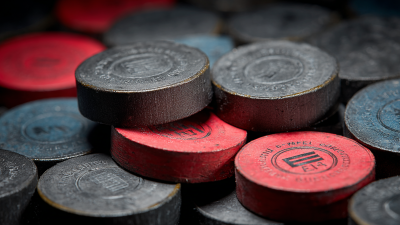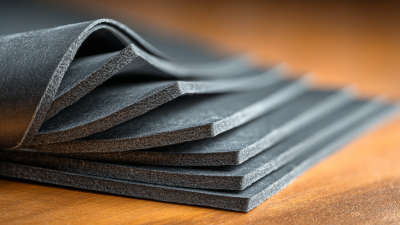Maximize Efficiency: The Ultimate Guide to Choosing Flexible Graphite Packing for Industrial Applications
In today's competitive industrial landscape, maximizing efficiency while ensuring dependable performance is crucial for success. One area where this is particularly evident is in the selection of sealing materials, specifically Flexible Graphite Packing. According to a recent industry report, the global market for sealing materials is projected to grow at a CAGR of 4.2% from 2023 to 2030, driven by the increasing demand for reliable sealing solutions in various sectors, including oil and gas, chemical processing, and power generation.
 Flexible Graphite Packing stands out as a preferred choice due to its excellent thermal stability, chemical resistance, and ability to withstand high pressure and temperature environments. As industries continue to seek ways to enhance process efficiency and reduce downtime, understanding the key attributes and applications of Flexible Graphite Packing will be essential for making informed procurement decisions.
Flexible Graphite Packing stands out as a preferred choice due to its excellent thermal stability, chemical resistance, and ability to withstand high pressure and temperature environments. As industries continue to seek ways to enhance process efficiency and reduce downtime, understanding the key attributes and applications of Flexible Graphite Packing will be essential for making informed procurement decisions.
Understanding Flexible Graphite Packing: Properties and Benefits for Industry
Flexible graphite packing is a versatile sealing solution widely used in industrial applications due to its unique properties. One of the key characteristics of flexible graphite is its high thermal resistance, which allows it to perform effectively in extreme temperatures without deteriorating. This thermal stability ensures that the sealing integrity is maintained, reducing the likelihood of leaks and potential downtime in critical systems. Additionally, flexible graphite is chemically resistant to a wide range of substances, making it an ideal choice for industries dealing with harsh chemicals and aggressive environments.
Another significant benefit of flexible graphite packing is its excellent compressibility and conformability. This means it can adapt to various surface irregularities, providing a reliable seal that can withstand vibration and thermal cycling. As a result, it minimizes wear and extends the lifespan of both the packing material and the equipment it protects. The ease of installation further enhances its appeal, often leading to reduced maintenance time and costs. Overall, understanding these properties and benefits enables industries to optimize their choice of sealing solutions, leading to improved efficiency and operational reliability.
Maximize Efficiency: The Ultimate Guide to Choosing Flexible Graphite Packing for Industrial Applications
| Property | Benefit | Application Area |
|---|---|---|
| High Temperature Resistance | Prevents damage in extreme conditions | Energy & Power Generation |
| Chemical Compatibility | Provides durability against various chemicals | Oil & Gas Industry |
| Low Friction | Reduces wear on equipment | Manufacturing Processes |
| Good Thermal Conductivity | Enhances heat dissipation | Aerospace Applications |
| Flexible and Resilient | Allows for easy installation and maintenance | Valve Sealing |
Key Performance Indicators: How to Assess Graphite Packing for Specific Applications
When selecting flexible graphite packing for industrial applications, it is essential to establish key performance indicators (KPIs) that align with the specific requirements of your operation. Start by assessing the thermal and chemical resistance of the graphite material. High-temperature performance is critical in industries such as petrochemicals and power generation, where packing must endure extreme conditions without degrading. Additionally, consider the compatibility of graphite packing with the fluids being contained, as improper selection can lead to premature failure and increased downtime.
Another important KPI is the pressure retention capability of the graphite packing. Depending on the application, the packing must maintain a tight seal under varying pressures to prevent leaks and ensure operational safety. Evaluating the compression set and resilience of the graphite material will provide insights into its ability to recover and maintain a seal over extended periods. Lastly, examining the installation and maintenance requirements will help ensure that the chosen packing provides long-term efficiency and reliability, ultimately supporting optimal performance in your industrial processes.

Cost-Benefit Analysis: Evaluating the Long-term Savings of High-Quality Graphite Packing
When evaluating the cost-effectiveness of flexible graphite packing for industrial applications, it's essential to consider the long-term savings associated with investing in high-quality materials. According to a recent industry report by Smithers Pira, upgrading to premium flexible graphite can yield up to 30% savings on maintenance and replacement costs over a five-year period. This reduction is attributed to the superior durability and reliability of high-quality graphite packing, which can significantly decrease unplanned downtime and extend the lifespan of machinery.
Tip: Always assess the specific operating conditions of your equipment when choosing graphite packing. Factors such as temperature, pressure, and the type of fluids being sealed can influence the performance and longevity of packing materials.
Moreover, an analysis by Freedonia Group highlights that while the initial cost of high-quality flexible graphite packing might be higher, the overall return on investment can be substantial. Companies that view maintenance expenses as a crucial metric often find that the durability of graphite packing allows for fewer replacements and lower labor costs, enhancing overall operational efficiency. This is particularly evident in industries such as petrochemicals and power generation, where the right packing solution can lead to significant operational savings.
Tip: Conduct a thorough comparison of maintenance schedules and packing lifespans to understand the true financial impact of your packing material choice. An informed decision can lead to improved productivity and reduced long-term costs.
Industry Standards and Certifications: Ensuring Quality in Flexible Graphite Packing Selection
When selecting flexible graphite packing for industrial applications, adhering to industry standards and certifications is paramount. These benchmarks ensure that the packing material meets specific performance criteria, enhancing reliability and longevity in demanding environments. Compliance with relevant standards such as ASTM, ISO, and API can help manufacturers assure customers of the quality and safety of their products. These certifications often indicate that the graphite packing has undergone rigorous testing for various properties, such as thermal resilience, chemical compatibility, and pressure resistance.
Moreover, understanding the implications of these standards can significantly influence the selection process. For instance, seeking out products that are certified under stringent guidelines can provide peace of mind that the packing will perform effectively under operational stresses. Additionally, companies that prioritize certification are typically more invested in quality control, leading to superior production processes and ultimately, greater customer satisfaction. In industries where downtime can be costly, choosing certified flexible graphite packing not only enhances operational efficiency but also mitigates risk, making it an essential factor in procurement decisions.
Case Studies: Successful Implementations of Graphite Packing in Various Industrial Sectors
Flexible graphite packing has proven to be a game-changer across various industrial sectors, enhancing operational efficiency and reliability. In the petrochemical industry, for instance, a report by the American Petroleum Institute (API) indicates that the adoption of flexible graphite packing has reduced leakage rates by up to 30%, significantly minimizing environmental risks and ensuring compliance with stringent regulations. Companies that implemented this packing material in their sealing solutions reported decreased maintenance costs, with annual savings averaging around $250,000.

In the power generation sector, a case study involving a major utility provider demonstrated that switching to flexible graphite packing in turbine applications resulted in a 40% increase in sealing lifespan. According to data gathered from the International Energy Agency (IEA), improved sealing materials can lead to overall efficiency gains of 5-10% in energy production. This not only translates to lower operational costs but also supports broader sustainability initiatives by reducing emissions associated with energy output. As industries strive for greater efficiency, the application of flexible graphite packing stands as a testament to innovation in material technology.
Related Posts
-

Maximizing Value with Best Flexible Graphite Gaskets: After-Sales Support and Maintenance Cost Insights for a Sustainable Future
-

Exploring Innovative Alternatives to Graphite Gasket Sheets for Diverse Applications
-

5 Essential Tips for Choosing the Right Flexible Graphite Gasket for Your Applications
-

How to Choose the Right Flexible Graphite Packing for Your Applications
-

7 Essential Tips for Choosing the Perfect Graphite Gasket Sheet for Your Needs
-

Top 10 Thermal Graphite Sheet Manufacturers from China at the 137th Canton Fair